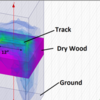OK.... I really don't wish to enter into this....
1) I can't run TMCC on my 2 rail layout without losing control of my DCS engines. I tried several recommended fixes and now I have to isolate TMCC to it's own layout. I never found a satisfactory solution.
2) I have encountered difficulties with DCS signal when the power or current drawn reaches the limits available. Whether it's from too many engines receiving power in a single block, or even drawing down a Z500 or Z1000 brick. That's just one issue over the many spread over years of use.
I have also found that isolating the negative (or return) into blocks on my G scale DC layout helped with signal and control with large lash-ups. I was told that would not help but it did. Signal was fine with single engines but control suffered with several. It appeared when I upgraded to an older version of DCS and I never pinned down why it happened.
I don't have that issue with my O scale AC powered layout, but it maybe something to try if you get decent signal level but can't get large lash-ups to respond correctly. I imagine that would be difficult to do with many users having a buss type common return.
The best thing I have ever tried when encountering trouble adding engines was to have a dedicated TIU#1, and a remote with no other TIU's listed. Yet that seemed to fail later on with more upgraded DCS versions.
3) I can't stand reading fellow users attacking each other over solutions that they come up with. I don't care what works for you and what should not if you are just going to hammer each other until surrender. Knock it off. Tell me that the return on my large DC layout doesn't need to be blocked and I'll tell you it does. Pull out a scope, read me the DCS patent, etc., I don't care.
I have spoken with many users who don't like the moderation here, and or don't like the people who regularly devote their time to help here and maybe seemingly stubborn to new ideas at first. I will leave as I don't need any crap anymore. I have left several other forums as well.
Barry you are a very intelligent man and I respect you deeply but you seemed to attack this subject like there's no issue and I have seen them myself. You maybe right about the subject. You just may need to allow things to die off on their own.
Adrian, you also seem like an intelligent man and I respect your attempts at understanding why the system fails sometimes. Working with several very intelligent people in my past has helped me to look at issues and other people with better understanding. You have to realize you are opening some cans of worms from the past attacks from other brand loyalists. They want nothing other than to drive MTH to defeat. They have attacked me, my computers, and my choices of brands in the past. It's sad but true. I laugh now. It was ridiculous.
So you 2 are dividing the posters here and will undoubtedly cause grief and flame the fires. I have blocked many posters here in the past. I try not to as I can learn from even the worse. I unblocked GRJ for example, when he settled down from his seemingly attack on MTH years back. If he meant to or not, he came across as an enemy of MTH and me, as that's all I ran. He advised a user to rip out the PS2 guts as TMCC was a better choice. I as a MTH fan obviously don't agree with that, but that's his opinion. I think TMCC was way ahead of it's time and yet got passed by with technological advances, being stuck in the mud. So I still read his posts and learn from his help, yet disagree fundamentally with his choices.
Maybe you 2 will stay friendly and I hope you do. You both need to watch how you present your opinions. You are creating enemies whether you want to or not.
PS. my layout is one of the ones affected by TMCC when it's plugged in. I knew it years ago. I isolated it until I once again rewired and did not realize the grounds were connected and the gremlin reappeared.









